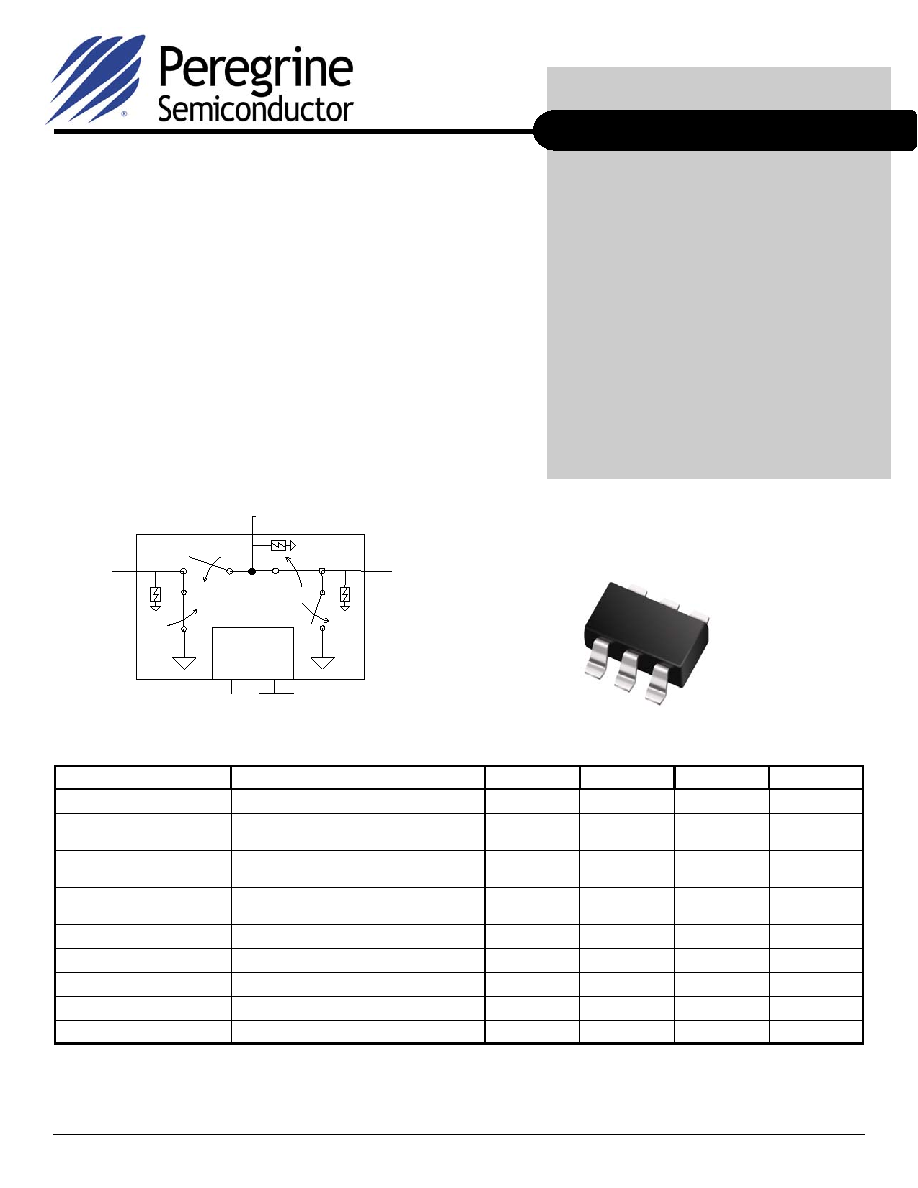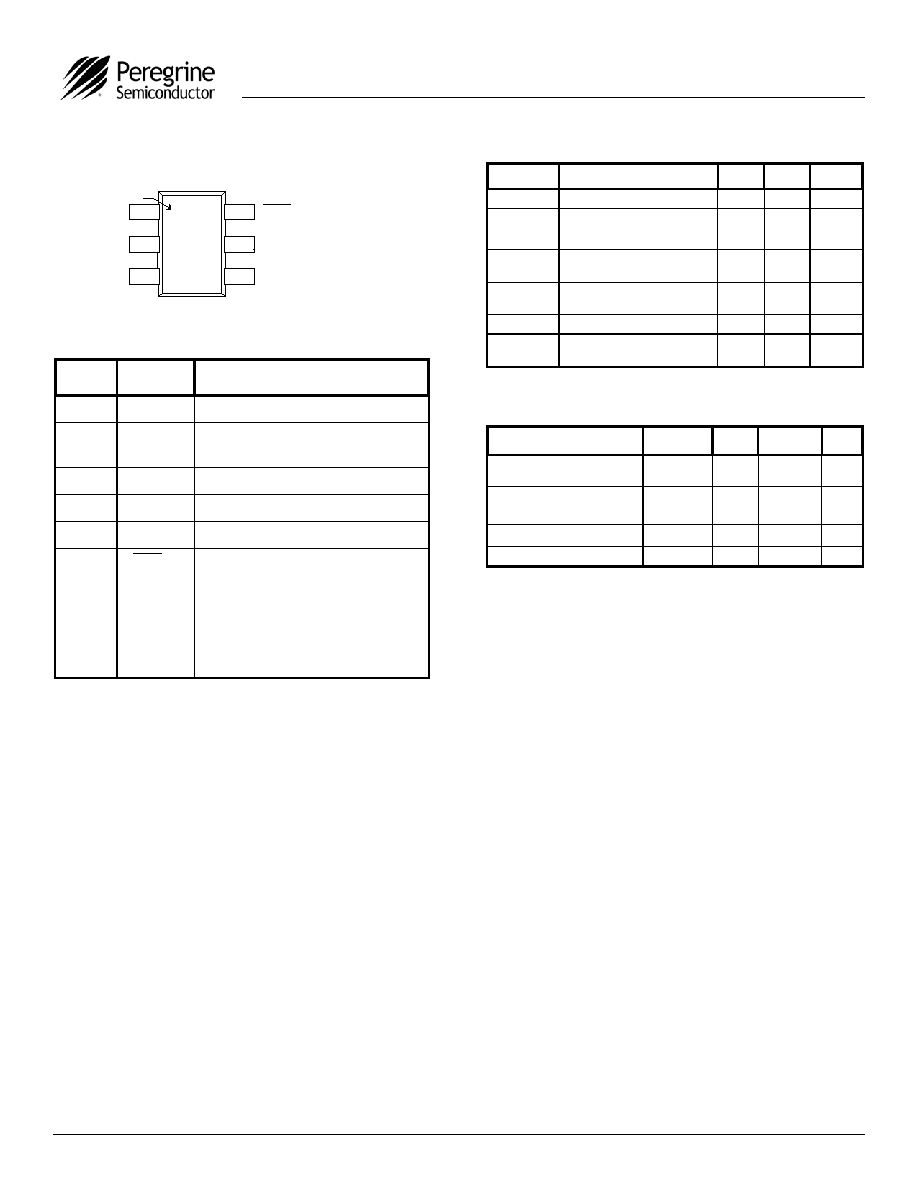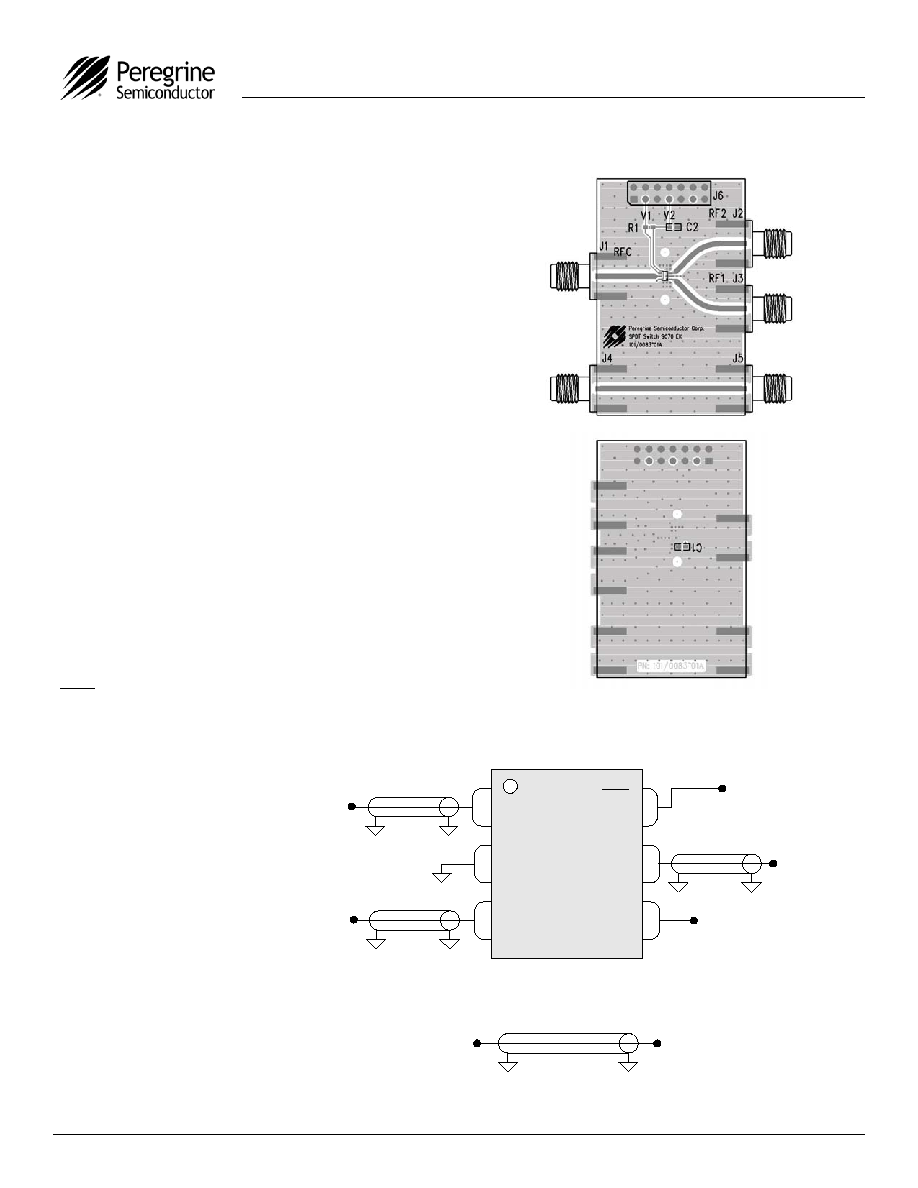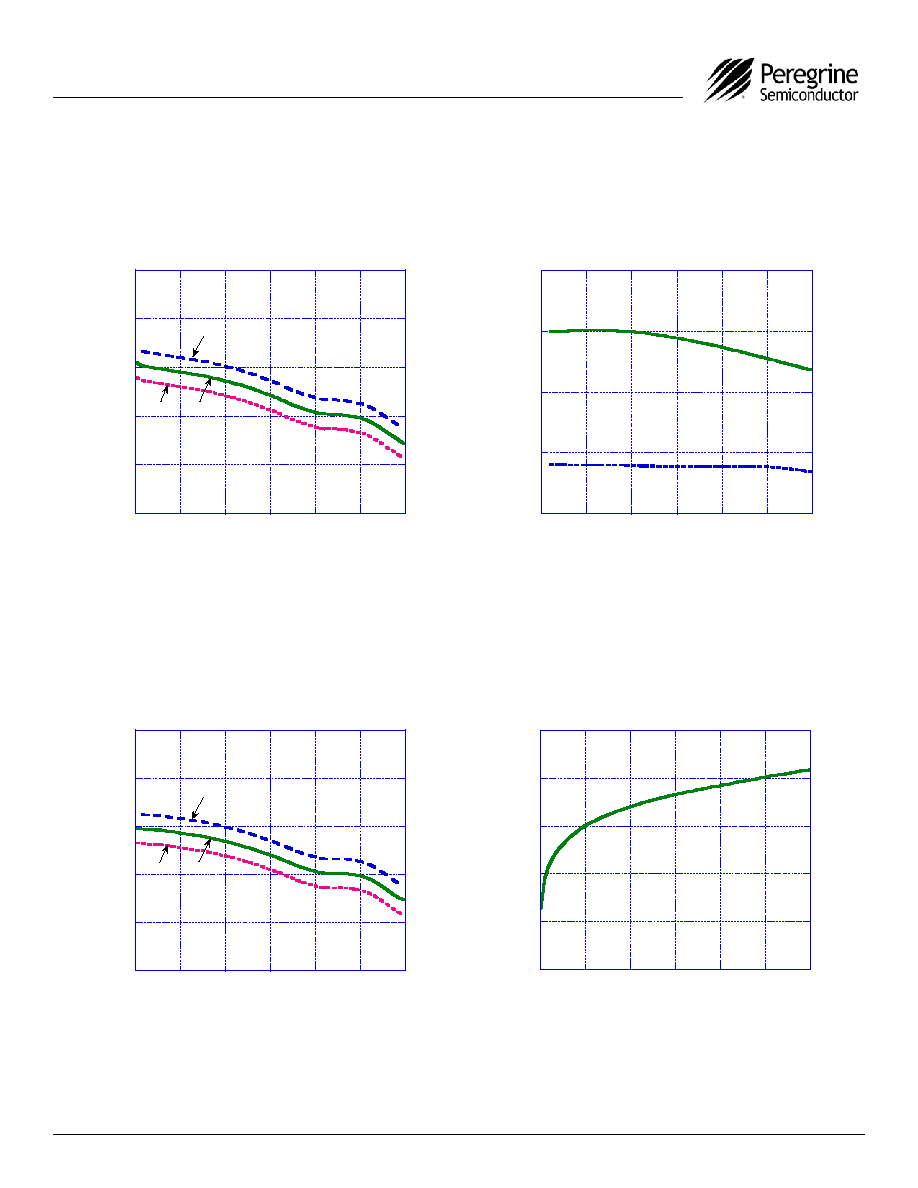 | –≠–ª–µ–∫—Ç—Ä–æ–Ω–Ω—ã–π –∫–æ–º–ø–æ–Ω–µ–Ω—Ç: 4239-52 | –°–∫–∞—á–∞—Ç—å:  PDF PDF  ZIP ZIP |

Page 1 of 8
Document No. 70-0068-01
www.psemi.com
©2005 Peregrine Semiconductor Corp. All rights reserved.
RFCommon
RF1
RF2
CMOS
Control
Driver
CTRL CTRL or V
DD
The PE4239 UltraCMOSTM RF Switch is designed to cover a
broad range of applications from DC through 3.0 GHz. This
reflective switch integrates on-board CMOS control logic with a
low voltage CMOS-compatible control interface, and can be
controlled using either single-pin or complementary control
inputs. Using a nominal +3-volt power supply voltage, a typical
input 1 dB compression point of +27 dBm can be achieved.
The PE4239 UltraCMOSTM RF Switch is manufactured in
Peregrine's patented Ultra Thin Silicon (UTSiÆ) CMOS
process, offering the performance of GaAs with the economy
and integration of conventional CMOS.
Product Specification
SPDT UltraCMOSTM RF Switch
Product Description
Figure 1. Functional Diagram
Figure 2. Package Type SC-70
PE4239
Features
∑
Single-pin or complementary CMOS
logic control inputs
∑
+3.0-volt power supply needed for
single-pin control mode
∑
Low insertion loss: 0.7 dB at 1.0 GHz,
0.9 dB at 2.0 GHz
∑
Isolation of 32 dB at 1.0 GHz, 23 dB at
2.0 GHz
∑
Typical input 1 dB compression point of
+27 dBm
∑
Ultra-small SC-70 package
Parameter Conditions
Minimum
Typical
Maximum
Units
Operation Frequency
1
DC
3000
MHz
Insertion Loss
1000 MHz
2000 MHz
0.7
0.9
0.85
1.05
dB
dB
Isolation
1000 MHz
2000 MHz
30
21
32
23
dB
dB
Return Loss
1000 MHz
2000 MHz
18
16
20
18
dB
dB
`ON' Switching Time
50% CTRL to 0.1 dB of final value, 1 GHz
300
ns
`OFF' Switching Time
50% CTRL to 25 dB isolation, 1 GHz
200
ns
Video Feedthrough
2
15
mV
pp
Input 1 dB Compression
2000 MHz
26
27
dBm
Input IP3
2000 MHz, 14 dBm input power
43
45
dBm
Notes: 1. Device linearity will begin to degrade below 10 MHz.
2. The DC transient at the output of any port of the switch when the control voltage is switched from Low to High or High to Low in a 50
test
set-up, measured with 1ns risetime pulses and 500 MHz bandwidth.
Table 1. Electrical Specifications @ +25 ∞C, V
DD
= 3 V (Z
S
= Z
L
= 50
)
6-lead SC-70

Product Specification
PE4239
Page 2 of 8
©2005 Peregrine Semiconductor Corp. All rights reserved.
Document No. 70-0068-01
UltraCMOSTM RFIC Solutions
Table 2. Pin Descriptions
Note 1: All RF pins must be DC blocked with an external series
capacitor or held at 0 V
DC
.
Figure 3. Pin Configuration (Top View)
Table 3. Absolute Maximum Ratings
Electrostatic Discharge (ESD) Precautions
When handling this UltraCMOSTM device, observe
the same precautions that you would use with
other ESD-sensitive devices. Although this device
contains circuitry to protect it from damage due to
ESD, precautions should be taken to avoid
exceeding the specified rating.
Latch-Up Avoidance
Unlike conventional CMOS devices, UltraCMOSTM
devices are immune to latch-up.
Table 4. DC Electrical Specifications
Pin
No.
Pin
Name
Description
1
RF1
RF1 port (Note 1)
2
GND
Ground connection. Traces should be
physically short and connected to
ground plane for best performance.
3
RF2
RF2 port (Note 1)
4
CTRL
Switch control input, CMOS logic level.
5
RFC
Common RF port for switch (Note 1)
6 CTRL
or
V
DD
This pin supports two interface options:
Single-pin control mode. A nominal 3-
volt supply connection is required.
Complementary-pin control mode. A
complementary CMOS control signal
to CTRL is supplied to this pin. By-
passing on this pin is not required in
this mode.
Symbol Parameter/Conditions Min Max Units
V
DD
Power supply voltage
-0.3
4.0
V
V
I
Voltage on any input
-0.3
V
DD
+
0.3
V
T
ST
Storage temperature
range
-65 150 ∞C
T
OP
Operating temperature
range
-40 85 ∞C
P
IN
Input power (50
)
30
dBm
V
ESD
ESD voltage (Human
Body Model)
1500
V
Parameter Min
Typ
Max
Units
V
DD
Power Supply
Voltage
2.7 3.0 3.3 V
I
DD
Power Supply Current
(V
DD
= 3V, V
CTRL
= 3V)
250
500
nA
Control Voltage High
0.7x V
DD
V
Control Voltage Low
0.3x V
DD
V
1
2
3
4
5
6
CTRL or V
DD
RFC
CTRL
RF1
GND
RF2
.
239
pin 1

Product Specification
PE4239
Page 3 of 8
©2005 Peregrine Semiconductor Corp. All rights reserved.
Document No. 70-0068-01
www.psemi.com
Control Voltages
Signal Path
Pin 6 (CTRL or V
DD
) = V
DD
Pin 4 (CTRL) = High
RFC to RF1
Pin 6 (CTRL or V
DD
) = V
DD
Pin 4 (CTRL) = Low
RFC to RF2
Table 5. Single-pin Control Logic Truth Table
Table 6. Complementary-pin Control Logic
Truth Table
Control Voltages
Signal Path
Pin 6 (CTRL or V
DD
) = Low
Pin 4 (CTRL) = High
RFC to RF1
Pin 6 (CTRL or V
DD
) = High
Pin 4 (CTRL) = Low
RFC to RF2
Control Logic Input
The PE4239 is a very versatile RF CMOS switch
that supports two operating control modes; single-
pin control mode and complementary-pin control
mode.
Single-pin control mode enables the switch to
operate with a single control pin (pin 4) supporting
a +3-volt CMOS logic input, and requires a
dedicated +3-volt power supply connection on pin
6 (V
DD
). This mode of operation reduces the
number of control lines required and simplifies the
switch control interface typically derived from a
CMOS
µ
Processor
I/O port
.
Complementary-pin control mode allows the
switch to operate using complementary control
pins CTRL and
CTRL
(pins 4 & 6), that can be
directly driven by +3-volt CMOS logic or a suitable
µ
Processor
I/O port. This enables the PE4239 to
be used as a potential alternate source for SPDT
RF switch products used in positive control
voltage mode and operating within the PE4239
operating limits.

Product Specification
PE4239
Page 4 of 8
©2005 Peregrine Semiconductor Corp. All rights reserved.
Document No. 70-0068-01
UltraCMOSTM RFIC Solutions
Evaluation Kit
The SPDT Switch Evaluation Kit board was
designed to ease customer evaluation of the
PE4239 SPDT switch. The RF common port is
connected through a 50
transmission line to the
top left SMA connector, J1. Port 1 and Port 2 are
connected through 50
transmission lines to the
top two SMA connectors on the right side of the
board, J3 and J2, respectively. A through
transmission line connects SMA connectors J4
and J5. This transmission line can be used to
estimate the loss of the PCB over the
environmental conditions being evaluated.
The board is constructed of a two metal layer FR4
material with a total thickness of 0.031". The
bottom layer provides ground for the RF
transmission lines. The transmission lines were
designed using a coplanar waveguide with ground
plane model using a trace width of 0.0476", trace
gaps of 0.030", dielectric thickness of 0.028",
metal thickness of 0.0021" and
r
of 4.4.
J6 provides a means for controlling DC and digital
inputs to the device. Starting from the lower left
pin, the second pin to the right (J6-3) is connected
to the device V1 or CTRL input. The fourth pin to
the right (J6-7) is connected to the device V2 or
CTRL/V
DD
input.
Figure 4. Evaluation Board Layout
Figure 5. Evaluation Board Schematic
CTRL
or V
DD
CTRL
RF2
RFC
GND
RF1
J6-3
J2
J1
J3
J4
J5
J6-7

Product Specification
PE4239
Page 5 of 8
©2005 Peregrine Semiconductor Corp. All rights reserved.
Document No. 70-0068-01
www.psemi.com
20
30
40
50
60
20
30
40
50
60
0
500
1000
1500
2000
2500
3000
I
I
P3 (
d
Bm
)
1
d
B C
o
m
p
r
e
s
s
i
on
P
o
i
n
t
(
d
Bm
)
Frequency (MHz)
Typical Performance Data @ -40 ∞C to 85 ∞C (Unless otherwise noted)
Figure 7. Input 1 dB Compression Point & IIP3
(Typical performance @ 25 ∞C)
Figure 9. Isolation ≠ RFC to RF1
Figure 8. Insertion Loss ≠ RFC to RF2
Figure 6. Insertion Loss ≠ RFC to RF1
-1.5
-1.2
-0.9
-0.6
-0.3
0
0
500
1000
1500
2000
2500
3000
I
n
se
r
t
i
o
n
L
o
ss
(
d
B
)
Frequency (MHz)
I
n
se
r
t
i
o
n
L
o
ss
(
d
B
)
-40∞C
25∞C
85∞C
-100
-80
-60
-40
-20
0
0
500
1000
1500
2000
2500
3000
Is
ol
ati
o
n
(
d
B
)
Frequency (MHz)
-1.5
-1.2
-0.9
-0.6
-0.3
0
0
500
1000
1500
2000
2500
3000
I
n
s
e
rt
i
o
n
L
o
s
s
(d
B
)
Frequency (MHz)
I
n
s
e
rt
i
o
n
L
o
s
s
(d
B
)
-40∞C
25∞C
85∞C




